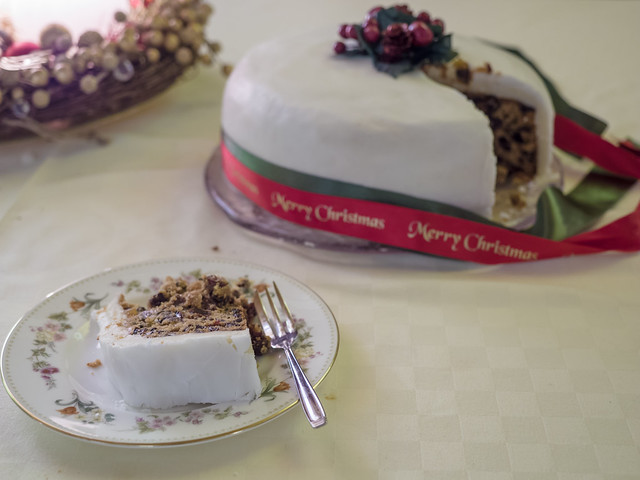Christmas Cake
The rich fruit cake that is often associated with Christmas were originally Twelfth Cakes (which were eaten at the parties on Twelfth Night ending the 12 Days of Christmas on 5th January in the UK). These started as enriched fruit cakes, more like Italian Pantone Christmas Cakes.
It then became fashionable to have large iced decorations on and over the cake (using 'Royal Icing' which sets very hard), to show you were rich enough to be able to afford lots of sugar to make the icing. So the cake had to become more rich, solid and full of fruit to support the icing.
During the industrial revolution, in the UK, the 12 Days of Christmas became less important, because more people lived in towns and cities and had to start working again directly after Christmas Day and Boxing Day. So the big celebrations were moved to Christmas rather than Twelfth Night and the cakes became Christmas Cakes. The term Christmas Cake was first used in countries like Australia and New Zealand rather than in the UK.
Twelfth Cakes also had a bean or pea cooked in them and the finder of the bean or pea became the King or Queen of the Twelfth Night party. Or there might be a bean and a pea; the bean for the King and the pea for the Queen. In the 1700s and 1800s it became popular that, rather than having a bean and/or pea in the cake, that the King and Queen were written on bits of paper and pulled from a hat. You could even buy packs of Twelfth Night characters (with more characters for other people to 'become' during the party). Each character came with a riddle or a joke - this could be where the idea to put jokes in Christmas Crackers came from.
When Twelfth Cakes became Christmas Cakes, the custom of putting tokens into a dish moved into the still 'alcoholic' Christmas Pudding; and Christmas Cakes also became a 'nicer' dish which could be served at afternoon tea which was very popular with middle and upper class Victorians.
The UK (and other countries with very strong historic connections to the UK) seem quite unusual in having big 'iced' cakes. Here's a Christmas Cake recipe which my family often uses.
Christmas Cakes around the World
Many other countries which eat rich fruit cakes at Christmas have them either with little or no decoration or a simple glaze and sometimes topped with nuts.
Some countries also have special cakes which are eaten at Christmas, New Year and Epiphany. Here are some of the cakes:
In Italy it's Panettone; In Spain Roscón is eaten at Epiphany (in the Catalan region it's known as Tortell or Gâteau des Rois); In France there's 'bûche de Noël' (a chocolate log) eaten at Christmas and 'Galette des Rois' at Epiphany; In Mexico 'Rosca de Reyes' is eaten at Epiphany; In Japan Christmas cake is a sponge cake filled and topped with cream and strawberries (and is this emoji 🍰); In Norway there's 'Hole Cake'; In The Netherlands, there's 'Kerstkrans' - Dutch Ring Cake; In Germany it's Stollen.
Last Updated: | Sources Information | Written by: James Cooper
